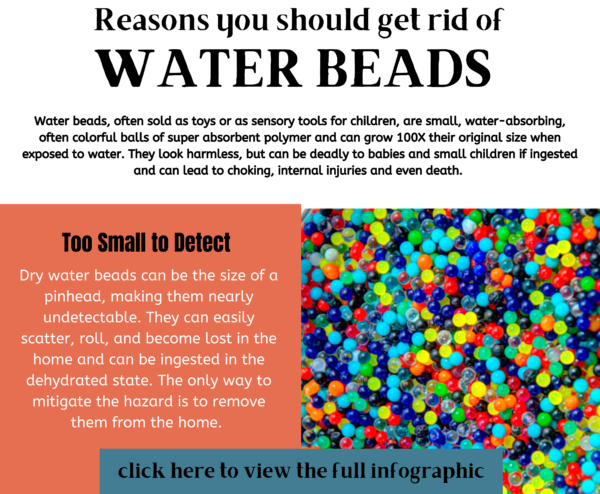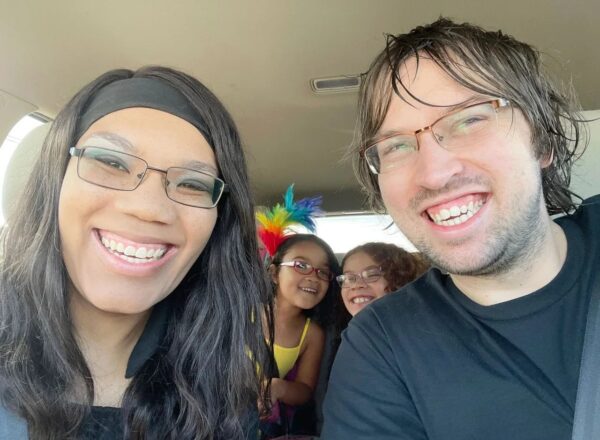 Earlier this month, there was a big recall of the Chuckle & Roar Ultimate Water Beads Activity Kits after the death of a 10-month-old child and serious injuries to a 9-month-old child. Water beads are made of small super-absorbent polymer crystals that can grow up to 1,500 times their size when placed in liquid. If ingested, the beads absorb bodily fluids and can lead to potentially life-threatening injuries, such as intestinal or bowel obstruction. We explored the dangers of water beads and why they remain such a problem in our previous blog speaking with Ashley Haugen, better known as That Water Bead Lady.
Earlier this month, there was a big recall of the Chuckle & Roar Ultimate Water Beads Activity Kits after the death of a 10-month-old child and serious injuries to a 9-month-old child. Water beads are made of small super-absorbent polymer crystals that can grow up to 1,500 times their size when placed in liquid. If ingested, the beads absorb bodily fluids and can lead to potentially life-threatening injuries, such as intestinal or bowel obstruction. We explored the dangers of water beads and why they remain such a problem in our previous blog speaking with Ashley Haugen, better known as That Water Bead Lady.
Ashley is a leading advocate speaking out against water beads after her own daughter, Kipley, was severely injured by these products. We continued our talk with Ashley about her experiences as a parent advocate and how she got started advocating for safety.
How did you get started advocating on water beads and getting your message out there, and what is the overall goal for your advocacy?
So, I want to tell you a story [that] answers the question as to why and how I got started. One day when Kipley was around four we were walking through a store, when I noticed the look on her face suddenly change. She went from enjoying our outing to being terrified. I noticed that she was staring at another mom with a kid in her cart, and` that mom had a package of water beads in her hand. Kipley has speech challenges due to her water bead injury, so talking can be really hard for her. When she looked at me, and she used every ounce of willpower to say, “friend safe,” I knew in that moment what she was asking me to do. So, I went up to that mom, and I told her what happened to Kipley.
 Our organization was recently informed that a 10-month-old baby girl passed away due to a water bead obstruction. I was telling my husband and Kipley happened to overhear, and her immediate response was to tell me to tell her mom, “I’m sorry,” and then she started crying. And she cried so hard. My daughter is the most courageous, compassionate, and loving person I have ever known. I am incredibly grateful to be her mom and I advocate because she asked me to. Our goal for the nonprofit is to make Kipley’s dream come true. She doesn’t want any more kids harmed by water beads and I am committed to empowering others through education, working with the medical community to update safety protocols, and holding corporations accountable who play a role in facilitating these products into the marketplace. The best-case scenario to keep kids safe is to secure a ban on these hazardous products so that they no longer make it into the homes of young children. Water beads are not safe. They are way too dangerous to be around kids.
Our organization was recently informed that a 10-month-old baby girl passed away due to a water bead obstruction. I was telling my husband and Kipley happened to overhear, and her immediate response was to tell me to tell her mom, “I’m sorry,” and then she started crying. And she cried so hard. My daughter is the most courageous, compassionate, and loving person I have ever known. I am incredibly grateful to be her mom and I advocate because she asked me to. Our goal for the nonprofit is to make Kipley’s dream come true. She doesn’t want any more kids harmed by water beads and I am committed to empowering others through education, working with the medical community to update safety protocols, and holding corporations accountable who play a role in facilitating these products into the marketplace. The best-case scenario to keep kids safe is to secure a ban on these hazardous products so that they no longer make it into the homes of young children. Water beads are not safe. They are way too dangerous to be around kids.
As a parent advocate, what are some challenges you faced on the road to safety?
 I’m going to have to confess. I didn’t anticipate encountering such a significant level of resistance and opposition toward the notion of updating outdated medical protocols and preventing childhood injuries by discouraging the presence of a dangerous product like water beads in the homes of children. I think that it is time for the medical community and for regulators to take a look at the underlying assumptions that are being presumed about parents, and to make sure that advocacy language is not unintentionally reinforcing industry narratives. [The narrative] shifts the focus away from looking critically at product design and manufacturing [and places it on the parents]. It’s time for healthcare professionals to understand that there are a lot of weaknesses within our current system. Specifically with water beads, one of the reasons that parents are so shocked when they learn that their child was injured by a water bead is because they followed the advice given. They used adult supervision consistently, they cleaned up the beads after they used them, they followed the age recommendation.
I’m going to have to confess. I didn’t anticipate encountering such a significant level of resistance and opposition toward the notion of updating outdated medical protocols and preventing childhood injuries by discouraging the presence of a dangerous product like water beads in the homes of children. I think that it is time for the medical community and for regulators to take a look at the underlying assumptions that are being presumed about parents, and to make sure that advocacy language is not unintentionally reinforcing industry narratives. [The narrative] shifts the focus away from looking critically at product design and manufacturing [and places it on the parents]. It’s time for healthcare professionals to understand that there are a lot of weaknesses within our current system. Specifically with water beads, one of the reasons that parents are so shocked when they learn that their child was injured by a water bead is because they followed the advice given. They used adult supervision consistently, they cleaned up the beads after they used them, they followed the age recommendation.
They did all those things — my family did those things — but our daughter was still injured, and other families have lost their children as well, and they did everything right.
What do you think is the best way to shift the public narrative back to looking critically at product design and manufacturing, especially for people who haven’t encountered these injuries and don’t know the flaws in the system?
Stories. I think people listening to the stories and listening to those who have been impacted by injuries from these beads is the best way to help counter that narrative. I also think that having a unified message from all the advocacy groups is very important. I think having that message in unison with the medical community is vital to push for change on this issue. We’re always going to have some people whose immediate response is defensiveness, and that is natural. However, we need to start encouraging people to push past that, and it’ll take all of us pointing out that this is a problem, and that this narrative is not true.
What is your suggestion for someone who would like to get involved in advocacy efforts?
Tell them to go to thatwaterbeadlady.org or send us an email at thatwaterbeadlady@gmail.com. Reach out, let us know that you want to help, and we can make that possible.
KID asked Ashley more questions about the dangers of water beads and signs for parents and caregivers to look out for if a child has ingested water beads in Part 1 of this interview. Follow us on social media @kidsindanger to see videos of our interview.


